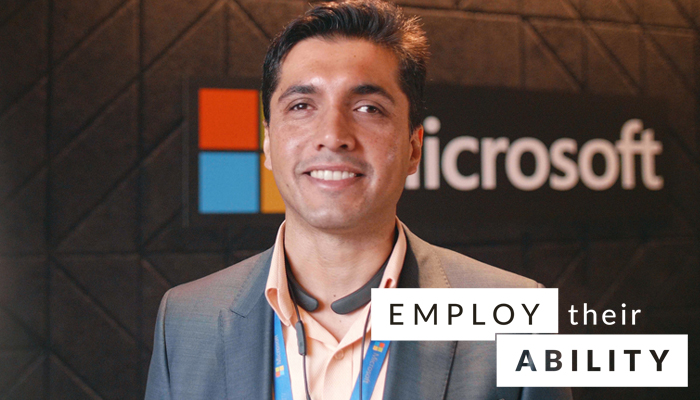How disability employment can spark innovation

Meet Kenny, Cloud Solution Architect at Microsoft Australia.
When Kenny Singh first discovered he had a retinal degenerative condition, he wasn’t sure what it would mean for his career.
“It was quite nerve wracking at the beginning of my working life. I didn’t quite know where to start,” he says.
Kenny is a Cloud Solution Architect at Microsoft Australia, where he works with large IT providers across the country in helping them build strong, profitable Cyber Security Consulting Delivery and Managed Services Practices that leverage Microsoft’s cutting-edge, AI-infused Security & compliance products and services.
“I’ve been with Microsoft for seven years now, and I’ve been really impressed with their stance on diversity. As an organisation, they have their own plans and procedures for acquiring any of the sorts of assistive technology that I might need – which for me is just a screen reader, and then the built in magnifier on Windows systems,” says Kenny.
For these kinds of adjustments, employers have access to a range of services and providers. Screen readers, for example, can be funded through the Employment Assistance Fund via JobAccess.
According to his manager, Jaron Cohen, Kenny brings a great deal of ability to his role at Microsoft.
“Kenny is one of the most senior members of the team, and he has a few phenomenal traits in the way he works,” says Jaron.
“I’ve never seen someone able to synthesise really complex technological concepts and audibly articulate them to an audience without any visual aids. For me, I think that his ability to turn these concepts into a story and relay information is much better because he can’t rely on visuals like so many of us,” he says.
But that’s just the beginning – Kenny’s presence in the office has had benefits for other members of the team, too.
“I know of at least one other team member who’s been open about her own disability since seeing Kenny be so visible and forthcoming about his,” he says.
“I would say it’s made me a better manager as well. Having someone with a vision impairment has made me stop and think about the way I communicate, and pushed me to engage with the team in a much more planned way – even just distributing content before a meeting so people have time to go over it. It doesn’t have to be difficult,” says Jaron.
When organisations reflect the communities in which they operate, their product benefits. And for Microsoft, diversity isn’t just good for people – it’s a path towards innovation.
“When you see how someone with an impairment is doing something, or working their way around a common challenge, it can lead to a new way of thinking,” says Kenny.
“The more diversity, the more insights and perspectives that you wouldn’t normally have. It’s a win for everyone.”
For organisations looking to see the benefits of hiring people with disability for themselves, JobAccess is here to help. The National Disability Recruitment Coordinator is available to help large organisations find and identify the right talent for them, and the Employment Assistance Fund can provide workplace assessments and financial assistance to make necessary adjustments.
Last updated:
